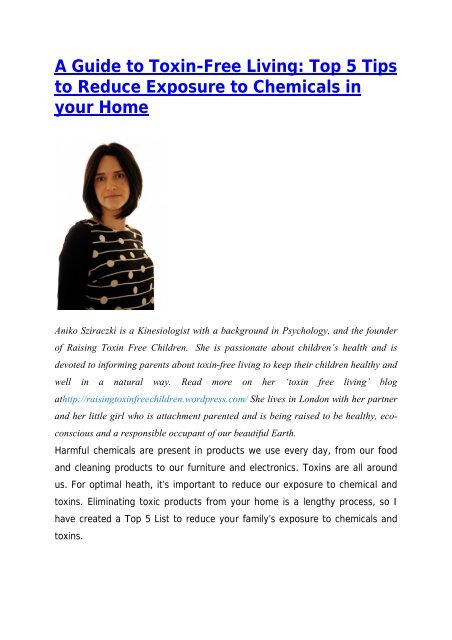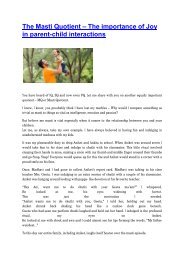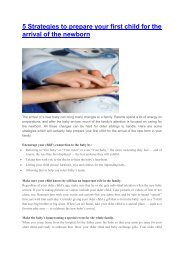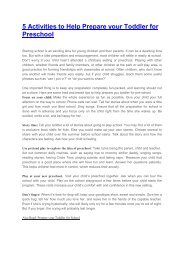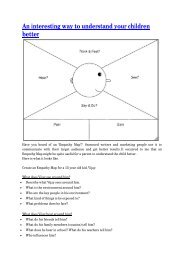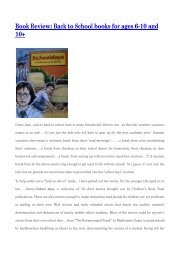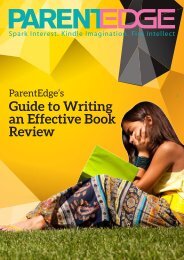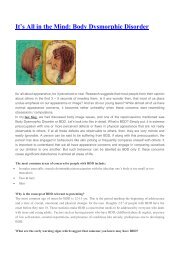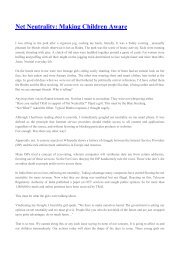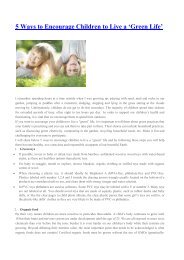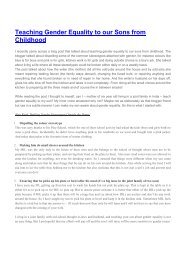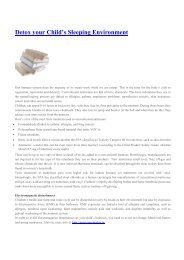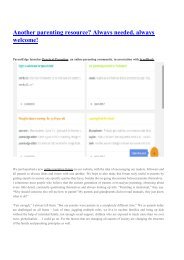A Guide to Toxin-Free Living: Top 5 Tips to Reduce Exposure to Chemicals in your Home
Harmful chemicals are present in products we use every day, from our food and cleaning products to our furniture and electronics. Toxins are all around us. For optimal heath, it’s important to reduce our exposure to chemical and toxins. Eliminating toxic products from your home is a lengthy process, so I have created a Top 5 List to reduce your family’s exposure to chemicals and toxins.
Harmful chemicals are present in products we use every day, from our food and cleaning products to our furniture and electronics. Toxins are all around us. For optimal heath, it’s important to reduce our exposure to chemical and toxins. Eliminating toxic products from your home is a lengthy process, so I have created a Top 5 List to reduce your family’s exposure to chemicals and toxins.
Create successful ePaper yourself
Turn your PDF publications into a flip-book with our unique Google optimized e-Paper software.
A <strong>Guide</strong> <strong>to</strong> <strong>Tox<strong>in</strong></strong>-<strong>Free</strong> <strong>Liv<strong>in</strong>g</strong>: <strong>Top</strong> 5 <strong>Tips</strong><br />
<strong>to</strong> <strong>Reduce</strong> <strong>Exposure</strong> <strong>to</strong> <strong>Chemicals</strong> <strong>in</strong><br />
<strong>your</strong> <strong>Home</strong><br />
Aniko Sziraczki is a K<strong>in</strong>esiologist with a background <strong>in</strong> Psychology, and the founder<br />
of Rais<strong>in</strong>g <strong>Tox<strong>in</strong></strong> <strong>Free</strong> Children. She is passionate about children’s health and is<br />
devoted <strong>to</strong> <strong>in</strong>form<strong>in</strong>g parents about <strong>to</strong>x<strong>in</strong>-free liv<strong>in</strong>g <strong>to</strong> keep their children healthy and<br />
well <strong>in</strong> a natural way. Read more on her ‘<strong>to</strong>x<strong>in</strong> free liv<strong>in</strong>g’ blog<br />
athttp://rais<strong>in</strong>g<strong>to</strong>x<strong>in</strong>freechildren.wordpress.com/ She lives <strong>in</strong> London with her partner<br />
and her little girl who is attachment parented and is be<strong>in</strong>g raised <strong>to</strong> be healthy, ecoconscious<br />
and a responsible occupant of our beautiful Earth.<br />
Harmful chemicals are present <strong>in</strong> products we use every day, from our food<br />
and clean<strong>in</strong>g products <strong>to</strong> our furniture and electronics. <strong>Tox<strong>in</strong></strong>s are all around<br />
us. For optimal heath, it’s important <strong>to</strong> reduce our exposure <strong>to</strong> chemical and<br />
<strong>to</strong>x<strong>in</strong>s. Elim<strong>in</strong>at<strong>in</strong>g <strong>to</strong>xic products from <strong>your</strong> home is a lengthy process, so I<br />
have created a <strong>Top</strong> 5 List <strong>to</strong> reduce <strong>your</strong> family’s exposure <strong>to</strong> chemicals and<br />
<strong>to</strong>x<strong>in</strong>s.
1. Take Your Shoes Off<br />
Leave <strong>your</strong> shoes at the door so outside chemicals don’t come <strong>in</strong>! By adopt<strong>in</strong>g<br />
this one easy habit, you will virtually leave thousands of potentially harmful<br />
(not <strong>to</strong> mention disgust<strong>in</strong>g!) chemicals at the door. Just imag<strong>in</strong>e this: you s<strong>to</strong>p<br />
at a petrol station <strong>to</strong> fill up <strong>your</strong> car where you step <strong>in</strong><strong>to</strong> some dripped petrol.<br />
You then walk home and step <strong>in</strong> <strong>to</strong> <strong>your</strong> liv<strong>in</strong>g room where <strong>your</strong> child is<br />
play<strong>in</strong>g. She crawls on the floor <strong>to</strong> pick up her <strong>to</strong>y and then she decides she<br />
wants some rais<strong>in</strong>s and grabs a handful and puts them <strong>in</strong> her mouth. She<br />
ends up with petrol <strong>in</strong> her mouth just because you didn’t remove <strong>your</strong> shoes.<br />
Imag<strong>in</strong>e how many chemicals and items of pure disgust you walk through<br />
each day with <strong>your</strong> shoes! You will do <strong>your</strong> family a world of good just by<br />
remov<strong>in</strong>g them when you get home.<br />
2. Buy healthier clean<strong>in</strong>g products!<br />
In order <strong>to</strong> elim<strong>in</strong>ate nasty chemicals from <strong>your</strong> house choose natural or <strong>to</strong>x<strong>in</strong><br />
free clean<strong>in</strong>g products; this will leave <strong>your</strong> family breath<strong>in</strong>g and liv<strong>in</strong>g<br />
healthier. You can pretty much clean <strong>your</strong> whole home with v<strong>in</strong>egar and<br />
bak<strong>in</strong>g soda. V<strong>in</strong>egar is effective for kill<strong>in</strong>g mold, bacteria, and germs due <strong>to</strong><br />
its level of acidity. It’s also safe on virtually every surface—even wood, as long<br />
as it’s sealed or f<strong>in</strong>ished—and it achieves a natural sh<strong>in</strong>e. If you need <strong>to</strong> work<br />
on sta<strong>in</strong>s or grease, then bak<strong>in</strong>g soda is <strong>your</strong> product.<br />
3. Re-th<strong>in</strong>k Your Laundry<br />
Avoid detergents that conta<strong>in</strong> phthalates, dyes, perfumes, and chlor<strong>in</strong>e<br />
bleach. These dangerous chemicals <strong>in</strong> <strong>your</strong> laundry can be absorbed <strong>in</strong><strong>to</strong> <strong>your</strong><br />
family’s sk<strong>in</strong> and lungs and should be avoided. A common <strong>in</strong>gredient found <strong>in</strong><br />
detergents is phthalates—chemicals that have been proven <strong>to</strong> <strong>in</strong>terfere with<br />
hormonal systems, disrupt tes<strong>to</strong>sterone production, and have other adverse<br />
affects. Chlor<strong>in</strong>e, another common <strong>in</strong>gredient <strong>in</strong> detergents, has been l<strong>in</strong>ked<br />
<strong>to</strong> breast cancer.
4. Know Your Plastic<br />
By learn<strong>in</strong>g what plastics are safe for eat<strong>in</strong>g and dr<strong>in</strong>k<strong>in</strong>g and how <strong>to</strong> care for<br />
them, you can reduce <strong>your</strong> family’s exposure <strong>to</strong> leached chemicals and<br />
dangerous <strong>to</strong>x<strong>in</strong>s. Bisphenol A—commonly abbreviated as BPA—is a <strong>to</strong>xic<br />
chemical that’s everywhere, especially <strong>in</strong> our dishes. Many of the plates, cups,<br />
and bowls you’ve gathered conta<strong>in</strong> BPA—even <strong>your</strong> Tupperware’s not<br />
immune. Always check the bot<strong>to</strong>m of the dish <strong>to</strong> make sure the letters PC<br />
(polycarbonate) are NOT on the bot<strong>to</strong>m. BPA is conta<strong>in</strong>ed <strong>in</strong> these plastics.<br />
5. Get Smart about Food<br />
Milk and other dairy products can conta<strong>in</strong> dangerous hormones, so<br />
understand how <strong>to</strong> read <strong>your</strong> labels <strong>to</strong> purchase healthier products. Also learn<br />
what produce conta<strong>in</strong>s the most pesticides and which you should always<br />
purchase organic whenever possible. When it comes <strong>to</strong> milk, raw varieties<br />
from grass-fed, antibiotic- and hormone-free cows are best. The safest milk <strong>to</strong><br />
give <strong>to</strong> <strong>your</strong> children is unpasteurised and non-homogenised milk. The most<br />
pesticide polluted fruits and vegetables are: strawberries, celery, peaches,<br />
apples, blueberries and peppers.<br />
F<strong>in</strong>ally, limit children’s mobile phone use. A child’s bra<strong>in</strong> absorbs twice the<br />
cell phone radiation as an adult’s. Health agencies <strong>in</strong> at least a dozen<br />
countries recommend limits for children’s cell phone use, such as for<br />
emergency situations only. Today the evidence is mount<strong>in</strong>g that mobile phone<br />
usage causes a range of adverse effects <strong>in</strong> people. The most significant<br />
research shows the possible connections between frequent mobile phone use<br />
and neurological problems <strong>in</strong>clud<strong>in</strong>g an <strong>in</strong>creased <strong>in</strong>cidence of bra<strong>in</strong> tumours.<br />
Other studies are also document<strong>in</strong>g higher rates of “head and neck cancers”<br />
which <strong>in</strong>clude mouth, nose, s<strong>in</strong>uses, salivary glands, throat, and lymph nodes<br />
<strong>in</strong> the neck.
Want <strong>to</strong> learn more about why these Five <strong>Tips</strong> can make a substantial<br />
difference <strong>in</strong> <strong>your</strong> family’s health? Then, do visit our FB page:<br />
https://www.facebook.com/rais<strong>in</strong>g<strong>to</strong>x<strong>in</strong>freechildren.<br />
Also see more <strong>in</strong>fo @ http://www.parentedge.<strong>in</strong>/blog


